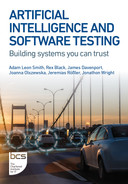GLOSSARY
Acceptance testing: Test level that focuses on determining whether to accept the system.*
Adversarial attacks: Where an attacker slightly perturbs (changes) the inputs to a model in order to influence its prediction(s).
AIOps: Industry category for machine learning analytics technology that enhances IT operations analytical capabilities.
Automated reasoning: Advanced area of computer science that is concerned with applying reasoning in the form of logic to computing systems to make inferences automatically.
Automation bias: Cognitive bias that occurs when a human decision-maker favours the recommendations of an automated decision-making system, over other inputs.
Black-box test technique: Test technique based on an analysis of the specification of a component or system.*
Chaos engineering: Discipline of experimenting on a software system in production in order to build confidence in the system’s capability to withstand turbulent and unexpected conditions.
Classification: Machine learning (ML) function that predicts the output class for a given input.
Component testing: Test level that focuses on individual hardware or software components.*
Concept drift: Change in users’ expected predictions from a model that is presented with the same input data.
Data pipeline: Infrastructure supporting an ML algorithm. It includes acquiring data, pre-processing and preparation, training one or more models and exporting the models to production.
Digital twin: The generation or collection of digital data representing a physical object.
Hyper-parameter: Variable set by a human in an ML model, before training the model.
Integration testing: Test level that focuses on interactions between components or systems.
Knowledge representation: Study of how to put knowledge into a form that a computer can reason with.
Neural network: Network of two or more layers of neurons, connected by weighted links with adjustable weights, which takes input data and produces an output. Also called an artificial neural network.
Neuron: Node in a neural network that takes input values and produces an output value, by combining the input values and applying an activation function to the result.
Ontology: Explicit specification of a conceptualisation.
Reasoning: Form of AI that generates conclusions from available information using logical techniques.
Regression: ML function that outputs continuous (typically, floating point) values.
Reinforcement learning: Task of training a model that makes decisions to maximise an objective, using a process of trial and error.
Shift left: Shifting the focus of testing effort towards the early design and testing phase, that is, shifting to the left of the systems or software development cycle.
Shift right: Shifting the focus of testing effort towards testing with users in a production environment.
Sub-symbolic AI: System based on techniques and models, using a numeric representation and implicit information encoding.
Symbolic AI system: System based on techniques and models, using symbols and structures.
System testing: Test level that focuses on verifying that a system as a whole meets specified requirements.*
Test coverage: Degree to which specified coverage items have been determined or have been exercised by a test suite expressed as a percentage.*
Test level: Specific instantiation of a test process.*
Test oracle: A source to determine an expected result to compare with the actual result of the system under test.*
User acceptance testing: Type of acceptance testing performed to determine if intended users accept the system.
Validation: Confirmation, through the provision of objective evidence, that the particular requirements for a specific intended use or application have been fulfilled.*
Verification: Confirmation, through the provision of objective evidence, that specified requirements have been fulfilled.*
White-box test technique: Test technique only based on the internal structure of a component or system.*
XPath: Query language for selecting nodes in XML.
*Copyright © International Software Testing Qualifications Board (hereinafter called ISTQB®).
